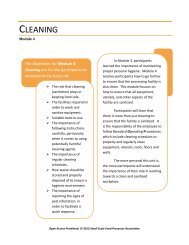Here - Small Scale Food Processor Association
Here - Small Scale Food Processor Association
Here - Small Scale Food Processor Association
Create successful ePaper yourself
Turn your PDF publications into a flip-book with our unique Google optimized e-Paper software.
ISO 22000:<br />
Ensuring <strong>Food</strong><br />
Safety<br />
By Albert Chambers<br />
<strong>Food</strong> safety is a top priority for<br />
every business along the supply chain, from<br />
input suppliers like the makers of packaging<br />
materials to the final marketers at retail<br />
and food service. However, demonstrating<br />
that your food business has put in place the<br />
systems you need to ensure the safety of your<br />
products and processes is something that<br />
more and more food businesses are now being<br />
asked to do.<br />
Today, food safety management system<br />
certification is a competitive advantage but<br />
tomorrow it may be both a market requirement<br />
and a regulatory requirement. That is<br />
the situation in Europe today and quite likely<br />
the situation in the United States next year,<br />
if legislation to amend their <strong>Food</strong> Drug and<br />
Cosmetics Act passes through its final stages<br />
in this session of Congress. To export your<br />
products your business will need to be certified<br />
by a third party.<br />
One option is to look to ISO 22000:2005<br />
<strong>Food</strong> safety management systems—requirements<br />
for any organization in the food chain<br />
and the other standards in its “family” (see<br />
sidebar). This international standard has<br />
been designed to incorporate the Codex<br />
Alimentarius approach to HACCP with a<br />
robust and auditable management systems<br />
approach. Key elements include:<br />
• System management: management responsibility<br />
and resource management.<br />
• Interactive communication within your<br />
organization and with your suppliers and<br />
customers.<br />
• Documentation requirements.<br />
• Planning and Realization of safe products:<br />
> Prerequisite programs;<br />
> Preliminary steps to enable hazard<br />
analysis;<br />
> Hazard identification and assessment<br />
of control measures;<br />
> Establishing the HACCP plan;<br />
> Verification planning;<br />
> Establishing a traceability system; and<br />
> Control of nonconformity.<br />
• Validation and verification.<br />
• Improvement of the <strong>Food</strong> Safety Management<br />
System (FSMS).<br />
A food manufacturer with an existing<br />
food safety program can incorporate the<br />
elements of ISO 22000 into their existing<br />
system by using a stepwise approach. If you<br />
already have Good Manufacturing Practices<br />
(GMPs) and Hazard Analysis Critical Control<br />
Point (HACCP) the transition can be made<br />
by adding the key management system components.<br />
If your business is in the midst of<br />
developing its food safety control measures,<br />
then ISO 22000 provides your business with<br />
a toolkit and an internationally accepted<br />
framework. <strong>Small</strong> manufacturers or other<br />
businesses involved in food supply chain<br />
can use “externally developed combinations<br />
of control measures” (an example might be<br />
the GMP documents developed by SSFPA),<br />
provided these are adapted to your processes<br />
and products.<br />
Over its first three years (2006-2008)<br />
more than 8,000 firms implemented<br />
ISO 22000. These included major food<br />
manufacturers like Kraft and Coca Cola and<br />
small firms in almost every segment of the<br />
food chain. This was a great start for a new<br />
standard—it represented a doubling in use<br />
every 12 months. That pace can be expected<br />
to continue now that the Global <strong>Food</strong> Safety<br />
Initiative (GFSI)—an international project<br />
whose members include many of the major<br />
retailers and food service companies in<br />
the world (including Loblaws, Sobeys,<br />
Wal-Mart and more)—has recognized<br />
two certification schemes based on ISO<br />
22000 alongside its other schemes such as<br />
the BRC and SQF. Certification to a GFSI<br />
recognized scheme will become a supplier<br />
requirement across North America, as it<br />
already is in much of Europe, over the next<br />
several years.<br />
To learn more about ISO 22000 check<br />
out the special issue of ISO’s Management<br />
Systems magazine at: www.iso.org/iso/<br />
iso22000_ims_08-3.pdf or order a copy<br />
of ISO 22000 <strong>Food</strong> Safety Management<br />
Systems – An easy-to-use checklist for small<br />
business – Are you ready? published jointly<br />
by ISO and the United Nation’s International<br />
Trade Centre.<br />
To learn about GFSI and the schemes it<br />
recognizes go to www.mygfsi.com.<br />
Funding assistance to implement ISO<br />
22000 is available in some provinces under<br />
the federal/provincial Growing Forward<br />
initiative. ■<br />
Albert Chambers is a consultant to the agrifood<br />
industry. He is currently the volunteer<br />
chairman of the Canadian Advisory Committee<br />
on the ISO 22000 family of standards<br />
(CAC/ISO TC34 SC17) and was an expert on<br />
the international working groups that developed<br />
ISO 22000, ISO 22003, ISO 22004<br />
and ISO 22005. He is also the lead author of<br />
the ISO checklist publication mentioned in<br />
this article.<br />
ISO 22000 “Family” of food<br />
safety system standards<br />
ISO 22000:2005 <strong>Food</strong> safety management<br />
systems – requirements for any<br />
organization in the food chain<br />
ISO 22002-1:2009 Prerequisite programmes<br />
on food safety – Part 1: <strong>Food</strong><br />
manufacturing<br />
ISO 22003:2007 <strong>Food</strong> safety management<br />
systems – Requirements for bodies<br />
providing audit and certification of food<br />
safety management systems<br />
ISO 22004:2005 <strong>Food</strong> safety management<br />
systems – Guidance on the application<br />
of ISO 22000:2005<br />
ISO 22005:2007 Traceability in the feed<br />
and food chain – General principles and<br />
basic requirements for system design and<br />
implementation<br />
14 We’re BIG on SMALL!















